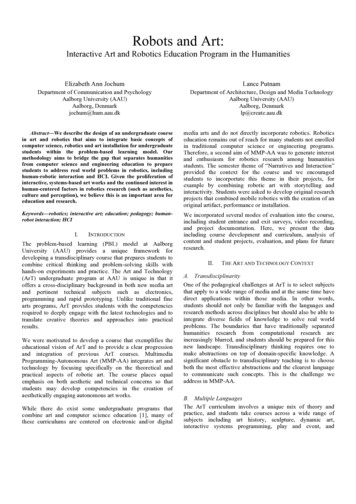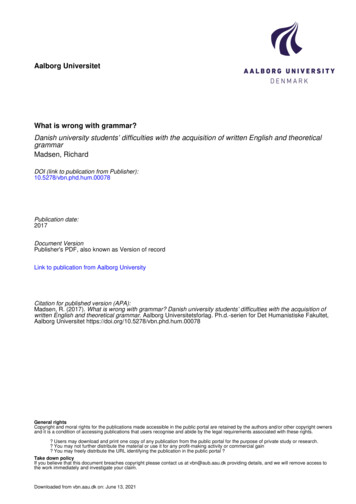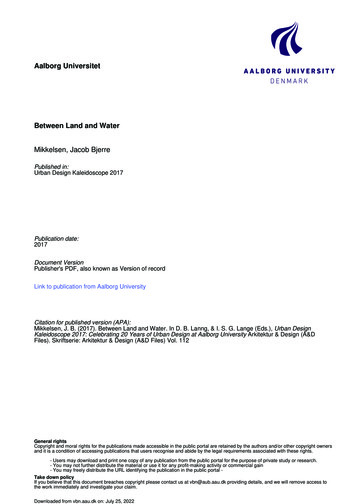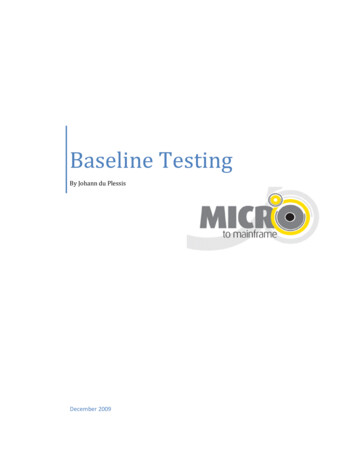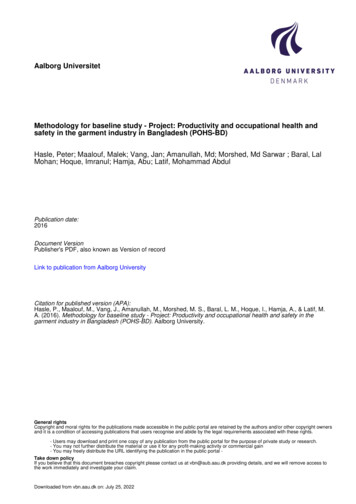
Transcription
Aalborg UniversitetMethodology for baseline study - Project: Productivity and occupational health andsafety in the garment industry in Bangladesh (POHS-BD)Hasle, Peter; Maalouf, Malek; Vang, Jan; Amanullah, Md; Morshed, Md Sarwar ; Baral, LalMohan; Hoque, Imranul; Hamja, Abu; Latif, Mohammad AbdulPublication date:2016Document VersionPublisher's PDF, also known as Version of recordLink to publication from Aalborg UniversityCitation for published version (APA):Hasle, P., Maalouf, M., Vang, J., Amanullah, M., Morshed, M. S., Baral, L. M., Hoque, I., Hamja, A., & Latif, M.A. (2016). Methodology for baseline study - Project: Productivity and occupational health and safety in thegarment industry in Bangladesh (POHS-BD). Aalborg University.General rightsCopyright and moral rights for the publications made accessible in the public portal are retained by the authors and/or other copyright ownersand it is a condition of accessing publications that users recognise and abide by the legal requirements associated with these rights.- Users may download and print one copy of any publication from the public portal for the purpose of private study or research.- You may not further distribute the material or use it for any profit-making activity or commercial gain- You may freely distribute the URL identifying the publication in the public portal Take down policyIf you believe that this document breaches copyright please contact us at vbn@aub.aau.dk providing details, and we will remove access tothe work immediately and investigate your claim.Downloaded from vbn.aau.dk on: July 25, 2022
Methodology for baseline studyProject:Productivity and occupational health and safetyin the garment industry in Bangladesh(POHS-BD)Final version: 31 October 2016
This manual is written by:Peter Hasle, Malek Maalouf, Jan VangSection of Sustainable Production, Department of Materials and Production, Aalborg UniversityCopenhagen, A. C. Meyers Vænge 15, 2450 Copenhagen SV, DenmarkMd. Amanullah, Md. Sarwar Morshed, Lal Mohan Baral, Imranul Hoque, Md. Abdul Latif, AbuHamjaAhsanullah University of Science & Technology (AUST), 141 & 142, Love Road, Tejgaon Industrial Area, Dhaka-1208Publisher: Department of Materials and Production, Aalborg University, ISBN 978-87-971394-1-7The report and the POHS-BD project is funded by the Danish development cooperation (Danida),project no. 14-07AAU1
Contents1Introduction . 42Design . 63Development of methodology. 83.1 Selection of relevant maturity models . 83.2 The Occupational Health and Safety Maturity Model . 83.3 The Productivity Maturity Model. 123.4 Selection of companies . 153.5 Expert testing. 163.6 Pilot testing . 163.7 Training of researchers . 164Data collection in companies . 184.1 Introductory visit . 184.2 Main data collection . 194.3 Follow up visit . 205Data analysis and report writing . 215.1 Writing detailed summaries of all interviews and observations. 215.2 Data entry of all quantitative data in spread sheet. 215.3 Scoring of all scales and maturity level. 215.3.1 Aggregate assessment example. 215.4 Writing a narrative report . 215.5 Validity, Reliability and Quality Control . 22Appendices . 23Appendix 1: Basic company information . 23Appendix 2: Interview guides and templates . 27Appendix 2.1 Interview checklists . 28Appendix 2.2 Interview sheet . 32Appendix 3: Observation guide . 34Appendix 4: OHS Maturity Level Assessment . 371.Leadership Commitment and Communication . 372.Business Policy . 383.Relation with contractors . 394.Relation with buyers . 405.Objectives, Targets & Performance Measurement . 416.Training. 422
7.Workforce Involvement . 438.OHS structure and accountability for OHS results . 459.Accident Investigation . 4610.Unsafe Behaviors and Unsafe Work Conditions . 4711.Legal requirements, Auditing and Reviews. 4712.Industrial relations, Welfare and Job Satisfaction . 4813. Scoring sheet . 50Appendix 5: Productivity Maturity Level Assessment . 511.Leadership commitment . 512.Employee involvement . 523.Training. 534.Continuous improvement. 545.Value stream mapping . 556.Control through Visibility. 567.Accounting support to Productivity . 578.5S/Housekeeping . 589.Preventive maintenance . 5910.Structured Flow/Pull Manufacturing . 6011.Suppliers and customers’ relationships . 6212.Scoring sheet . 63Appendix 6: Template for company report . 64Appendix 7: Procedure for uploading data . 66Appendix 8: Checklist and manual for quality control . 67References . 693
1 IntroductionThe project aims to create knowledge regarding sustainable co-development between productivityand occupational health and safety (OHS) in the readymade garment (RMG) industry in Bangladesh.As such, this project aims to directly and indirectly improve productivity and OHS practices amongBangladeshi companies. The companies are considered motivated to implement OHS improvementsas they simultaneously experience productivity gains. OHS is thereby transformed from being a costto becoming a means for productivity growth.The aim of the baseline study is to gain knowledge of the present level of productivity and OHSmaturity of the RMG firms, their development needs and their experience with integrating productivity and OHS as well as relations with the external buyers. The capability maturity for productivity isbased on continuous improvement maturity assessment and Gartner’s capability model from the extant continuous improvement and lean literatures (Womack, Jones and Roos, 1990; Womack andJones, 2003; Melenovsky and Sinur, 2006; Bessant and Francis, 1999). The maturity assessment encompasses both technical and organizational/behavioural dimensions with special attention to institutionalizing practices. The model allows organizations to identify their current level of maturity anddevise the actions needed to progress to the next maturity level. It is here applied by the researchers.The model consists of five levels ranging from ad hoc application of productive practices over codification and embedding of practices to systematic continuous improvement of practices. The organizational health and safety maturity assessment is based on the extant safety literature (Parker, Lawrieand Hudson, 2006; Dejoy, 2005). Parker et al.’s model has been used to describe the safety maturityrelated to culture and management system in many industries including oil, aviation and healthcare.Hudson’s model illustrates a five step progression from a “pathological” stage where there is a “nocare” culture and “no systems” through to a “generative” stage where managing risks is a way of lifeand fully integrated systems are effectively in place.The baseline study is conducted in 50 RMG firms constituting large, medium and small firms. Thefirms are identified through the so-called snowball technique from industry stakeholders (i.e.BGMEA, BKMEA) and from AUST University in Bangladesh. The learning from the baseline studyis used to identify areas for improvement which will feed the next step of the study. The next stepaims to intervene in 12 companies in order to elevate the current maturity level of the 12 companies4
to at least one level above. This step also entails devising a tool to identify sub-optimal situations inpractice. The interventions are designed in detail for each maturity level.5
2 DesignWhen looking at an organization and its activities, three main components can be identified: 'structure', 'processes', and 'culture' (Antonsen, 2009; Guldenmund, 2010). Organisational structure is aboutthe formal aspects of an organization. It is not only about the infrastructure and hardware, but alsoabout the distribution of tasks, roles and responsibilities, control, and authority (power). Structurethus determines how the organizational mission should be achieved, and by whom (Guldenmund,2010, p. 85).Organisational processes refer to the core business and supporting processes in an organization. Thesealso comprise management processes and systems, as well as the social/interactional processes i.e.everything that relates to social relationships, communication, and exchange of information betweenthe workers in an organization. These interactional aspects can be seen in features like cooperation,trust, competition, or conflict (Antonsen, 2009, p. 45).Organisational culture, or corporate culture, applies more to the informal aspects of work and organising. It is about what people in an organization value as important, and about their underlying common beliefs and convictions. Organisational culture is often described as "the way we do thingsaround here" (Guldenmund, 2010, p. 21). There is not just one overall culture within an organization.Several (sub) cultures can co-exist, typically linked with different units, departments, hierarchicallayers, and occupations. These cultures within an organization are not isolated but are obviously affected by the national culture, and specific characteristics from a country, region, sector, industry, oroccupation (Antonsen, 2009).In order to analyse and better understand OSH and Productivity within an organization, the organizational triangle model (structure, processes, culture) and the interrelated perspectives of the threeorganizational dimensions are taken into consideration. Take, for example, an industrial company,one of whose employees has experienced a serious accident. The investigation following the accidentreveals that some minor incidents preceded this accident. These 'near-misses' were, however, notreported to the line management, and did not lead to any appropriate measures that could have reducedthe risk of the accident happening. From the processes perspective, it could be argued that there wasa lack of communication on safety issues. Poor communications on safety issues could also be related6
to structural factors in organizations e.g. because line managers, supervisors, and/or workers are notaware of their specific role and responsibilities related to safety. The problem could also lie in the"softer", cultural aspects of the organization. Working safely and preventing accidents may not formpart of the company’s value system, leading to an atmosphere of non-compliance with good operatingpractices, poor safety communication and failure to take effective action to remedy safety and healthproblems.As for the assessment of an organization maturity levels for OSH and Productivity, it is important tonote that while structures and processes involve concrete elements, culture involves abstract elementsrelated to attitudes and behaviours. These abstract and soft elements pose extra challenges for theassessment of both OHS and productivity maturity. In order to capture these complexities associatedwith culture assessment, scholars have recommended the combination of different and reinforcingapproaches. For instance, Guldenmund (2010, pp. 183 ff., p. 197) distinguishes respectively the analytic (psychological), the pragmatic, and the academic (anthropological) approach to the study ofoccupational safety culture (Table 1). In this baseline study, we rely on the academic and pragmaticapproaches for assessing the maturity levels of safety and productivity of the companies.Table 1: The analytic, academic and pragmatic approach towards safety cultureMain approachTimefocusInformation aimed toretrieveResearch characteristicsAssessment strategy and methodsAcademic (anthropological)PastQualitative informationDescriptiveFieldwork, ethnographical-inspiredmethods (e.g. document analysis, observations, focus groups, interviews,etc.)Analytical (psychological)PresentQuantitative information, on the safetyclimateDescriptiveSafety climate scales, questionnairesPragmatic (experiencebased)FutureSafety culture maturity(level)Normative, prescriptiveBehaviourally Anchored Rating ScalesSource: based on Guldenmund (2010, pp. 183 ff., p. 197).7
3 Development of methodology3.1 Selection of relevant maturity modelsAssessment tools are critical to the success of continuous improvement of productivity and OHS —or in the successful implementation of any world class manufacturing principles for that matter. Assessment tools have many functions, most important perhaps as a "roadmap" that illustrates the company's current status among its most important performance parameters. A good assessment is alsoinvaluable in identifying opportunities for improvement and the parameters in which action plansshould be designed. For an assessment tool to fulfil these functions, it must accurately reflect thenature and complexity of what is being assessed.In this study, the development of the methodology started with a review of the maturity assessmentmodels related to OHS and lean/continuous improvement available in the extant literature (Hudson,2001 & 2003; Bessant et al., 2001; Jorgensen et al., 2007). It was not possible to identify one modelthat fits perfectly the needs of this project. Based on this, we have drawn upon existing maturityassessment models for safety and lean/continuous improvement. In addition, stakeholders in the garment industry in Bangladesh have been interviewed as well as selected garment companies visited.The models of this study were built with more focus on the concrete elements and less emphasis onthe abstract elements of the organizations which is considered more suitable for organizations withvarying levels of OHS and productivity maturity - as it is the case in Bangladesh RMG industry.3.2 The Occupational Health and Safety Maturity ModelThe models of maturity assessment available in the extant literature focus on the assessment of thetraditional safety culture, but lack the dimensions for health assessment dimensions. One famousmodel is depicted in Figure 1, which illustrates a five step progression from a “reactive” stage wherethere is a “no care” culture and “no systems” through to a “generative” stage where managing risksis a way of life and fully integrated systems are effectively in place. This model is strongly inspiredby the five- stage model of Hudson and colleagues (Hudson, 2001; Hudson, 2003; Parker et al., 2006).Since our research interest is to investigate both health and safety maturity, we have built on thismodel by adding the health features for each stage of maturity.8
Figure 1. The Health and Safety Maturity modelThe descriptions of each stage of OHS maturity model are given below.Reactive:Organizations act only action after incidents. At this stage an organization sees OHS as an externalrequirement, and not as an aspect of conduct that will allow it to succeed. The external requirementsare those of government, the legal framework and the regulatory bodies. There is no awareness of thebehavioral and attitudinal aspects of OHS. OHS is seen as a technical issue, to be achieved by compliance with rules and regulations.Some characteristics of an organization in this stage are:9
(1) Problems are not anticipated, and the organization reacts to each one as it occurs.(2) Communication between departments and functions is poor.(3) Collaboration and shared decision-making is limited.(4) People who make mistakes are blamed for their failure to comply with the rules.(5) There is not much listening or learning inside or outside the organization, which generally adoptsa defensive position when criticized.Formal:An organization at this stage considers OHS to be an organizational goal, even in the absence ofexternal requirements. Strategy and mechanisms for compliance are in place with little impact ondaily operations. OHS involves some collection of data. OHS is still primarily driven by managementand imposed rather than looked for by the workforce. Although there is growing awareness of behavioral issues, this aspect is largely missing from OHS management, which generally concentrates ontechnical and procedural solutions.Some characteristics of an organization in this stage are:(1) Strategy and practices for OHS improvement have been introduced to the company with yet littleeffect on daily operations(2) Management’s response to mistakes is to introduce more controls and procedures, and to providemore retraining.(3) The relationship between employees and management is adversarial, although there may be moreopportunities to discuss common goals.(4) The organization remains reactive in relation to problems, although there may be more anticipation of potential problems in planning.Deployed:The implementation of the OHS compliance is now a part of the organization's strategy and projectsand activities are planned on the basis of established goals and objectives. Knowledge of and practical10
experience with improving OHS are acknowledged and recognized in the organization, although initiatives are still focusing on pressing issues. Satisfactory performance improvements are achieved.Specific HR systems (i.e. selection, compensation, training functions) are aligned with OHS compliance objectives. Some characteristics of this level are:1.The role of management is to make sure that goals are achieved and that work objectives areclear to employees.2. The organization is willing to learn from external groups, especially new techniques and bestpractices.3. The interaction of people and technology is considered, but more from the viewpoint of increasing the efficiency of the technology.4. There is more teamwork.5. There is growing awareness of the impact of cultural issues in the workplace, although it isnot understood why added controls and training have not yielded the expected safety improvements.6. Management encourages interdepartmental and inter-functional communications.AutonomousWorkforce involvement starts to move the initiative away from a purely top down approach; howevertop management still plays a role in leading the improvement of the health and safety managementsystem. An organization in this stage has adopted the idea of continuous improvement and appliedthe concept to safety. There is a strong emphasis on communications, training, management style andimproving efficiency and effectiveness. People within the organization understand the impact of cultural issues on OHS.Some characteristics of an organization in this stage are:1. Problems are anticipated and dealt with before they occur.2. Collaboration between departments and functions is good.3. There is no goal conflict between safety and production.4. Almost all mistakes are viewed in terms of process variability with the emphasis placed on understanding what has happened, rather than finding someone to blame.11
5. Learning from others, both inside and outside the organization, is valued.6. People are respected and valued for their contribution.7. The relationship between management and employees is mutually supportive.8. People are aware of the impact of cultural issues, and these are considered in decision making.9. People are rewarded for improving processes, as well as results.10. People are considered to be an important part of organizational systems with attention given tosatisfying their needs, and not just to achieve technical efficiency.Way of lifeThis stage includes all the proactive stage features with active participation at all levels. Management's role is seen as coaching people to improve performance, rather than involving directly in safetyissues. OHS is perceived to be an inherent part of the culture and the business. Organizations arecharacterized by chronic unease as a counter to complacency.3.3 The Productivity Maturity ModelBased on the extant literature, a productivity assessment tool must address two perspectives or dimensions, each of which encompasses a number of variables. Specifically, the literature proposes thatan assessment tool must include the following:(1) A technical perspective, which reflects performance, methods, and tools in relationship to thegiven company's strategic "scope", as described by (Hines et al., 2004).(2) An organizational perspective, which reflects management, organizational and human capabilities, culture, and learning.Based on the literature review we identified maturity models related to continuous improvement/productivity (Bessant et al., 2001) and lean (Jorgensen et al., 2007). However, the continuousimprovement/productivity models identified in the literature were more complete and covered moreaspects of production and operations than the lean maturity models. Based on this, we combined bothmodels to create our own which have features of both the continuous improvement/productivity andlean models. The maturity model of this study (Figure 2) is based on a 1-to-5 rating scale in order toassess the Productivity Maturity level, where stage 1 represents the lowest level of maturity and stage5 is best in class.12
Figure 2: The Productivity Maturity ModelStage 1: ReactiveThis level is characterized by occasional rather random efforts at optimization in various organizational units, but these activities are not planned or implemented on the basis of an overall strategy ora specific manufacturing philosophy. The optimization projects are typically led by experts with littleto no general employee involvement. Organizational mechanisms and systems are not integrated withthe improvement philosophy and/or objectives. Some characteristics of this level are:1. Problem-solving random and ad hoc oriented2. No formal efforts or structure3. Occasional bursts punctuated by inactivity and non-participation4. Dominant mode of problem-solving is by specialists5. Short-term benefits6. No strategic impact13
Stage 2: FormalThe company has now chosen the improvement strategy that will serve as the basis for productionoptimization. Experts are leading the initiative and some workers have received basic training. Pilotprojects have been initiated in isolated units within the organization for the purpose of experimentingwith improvement tools and methods. At this stage, initiatives happen as a result of learning curveeffects associated with a particular process improvement projects and then fade out again. Improvement initiatives can also result from a short-term input - a training intervention, for example, - andleads to a small impact around those immediately concerned with it. These effects are often shortlived and much localized. Some characteristics of this level are:1. Increased training of the workforce on improvement tools2. Most projects done by experts with some participation of the workforce3. Structure and strategy of the improvement are in place before the full deployment phaseStage 3: DeployedThe implementation of the improvement initiative is now a part of the organization's strategy andprojects and activities are planned on the basis of established goals and objectives. Knowledge of andpractical experience with tools and methods as well as the manufacturing improvement are acknowledged and recognized at all levels of the organization, although initiatives are still primarily implemented according to an established plan. Satisfactory performance improvements are achieved. Specific HR systems (i.e. selection, compensation, training functions) are aligned with lean objectives tosupport improvement goals.Some characteristics of this level are:1. Formal attempts to create and sustain the improvement outcomes and practices2. Use of a formal problem-solving process3. Formal attempts to increase employees’ participation4. Training in basic Productivity/lean tools5. Structured idea management system6. Recognition system7. Can extend to cross-functional work but on an ad hoc basis14
Stage 4: AutonomousProductivity/Lean activities occur continuously from all areas of the organization. The practical understanding of improvement tools and methods is quite high and these are used actively by all members of the organization to develop and implement performance improvements. All HR functions arealigned with improvement objectives for the purpose of supporting long term sustainability. Focuson, e.g. career development and extended developmental activities (e.g. external education). Management is still directly involved in sustaining lean in the organization. Some characteristics of leanat this stage:1. All of the previous stage2. Formal deployment of strategic goals3. Monitoring and measurement of Productivity against these goalsStage 5: Way of lifeThe improvement strategy is no longer just an internal strategy and its impact is visible in activitiesthroughout the extended value chain level. Improvement activities are planned, implemented, andmonitored across the extended boundaries. Knowledge sharing and kn
The project aims to create knowledge regarding sustainable co-development between productivity and occupational health and safety (OHS) in the readymade garment (RMG) industry in Bangladesh.
